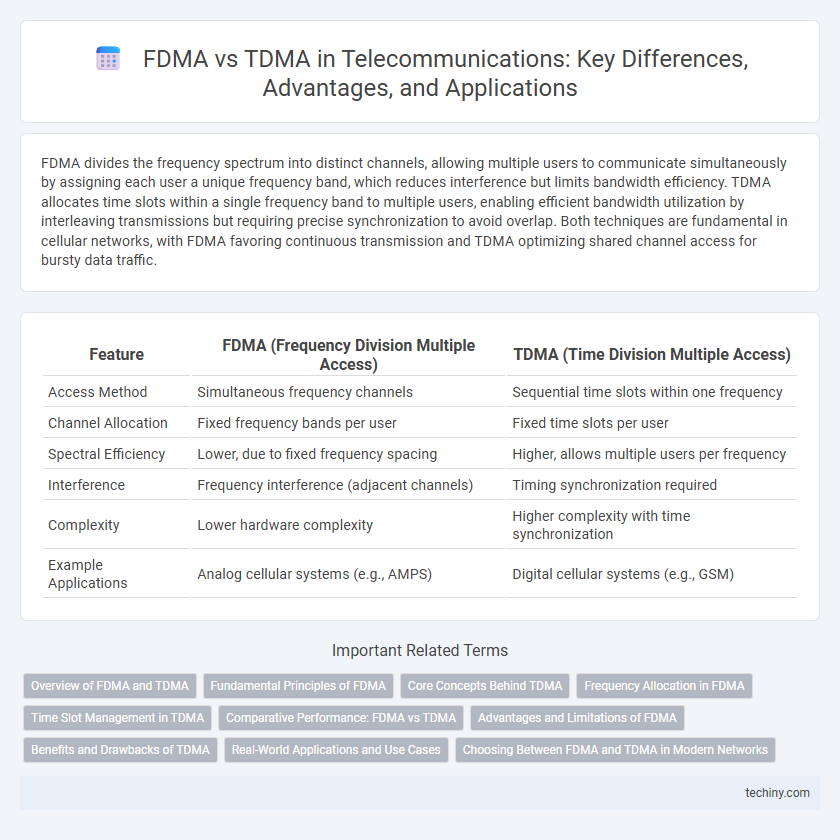FDMA divides the frequency spectrum into distinct channels, allowing multiple users to communicate simultaneously by assigning each user a unique frequency band, which reduces interference but limits bandwidth efficiency. TDMA allocates time slots within a single frequency band to multiple users, enabling efficient bandwidth utilization by interleaving transmissions but requiring precise synchronization to avoid overlap. Both techniques are fundamental in cellular networks, with FDMA favoring continuous transmission and TDMA optimizing shared channel access for bursty data traffic.
Table of Comparison
| Feature | FDMA (Frequency Division Multiple Access) | TDMA (Time Division Multiple Access) |
|---|---|---|
| Access Method | Simultaneous frequency channels | Sequential time slots within one frequency |
| Channel Allocation | Fixed frequency bands per user | Fixed time slots per user |
| Spectral Efficiency | Lower, due to fixed frequency spacing | Higher, allows multiple users per frequency |
| Interference | Frequency interference (adjacent channels) | Timing synchronization required |
| Complexity | Lower hardware complexity | Higher complexity with time synchronization |
| Example Applications | Analog cellular systems (e.g., AMPS) | Digital cellular systems (e.g., GSM) |
Overview of FDMA and TDMA
FDMA (Frequency Division Multiple Access) divides the available bandwidth into distinct frequency channels, allowing multiple users to transmit simultaneously on different frequencies. TDMA (Time Division Multiple Access) allocates separate time slots within a single frequency channel, enabling multiple users to share the same frequency by transmitting in rapid succession. Both FDMA and TDMA optimize spectrum efficiency in cellular networks by managing user access through frequency or time separation.
Fundamental Principles of FDMA
FDMA (Frequency Division Multiple Access) operates by allocating individual frequency bands to different users, enabling simultaneous transmission without interference. Each user is assigned a unique frequency channel within the available spectrum, ensuring dedicated bandwidth and continuous communication. This principle contrasts with TDMA's time-based channel sharing, emphasizing FDMA's reliance on frequency separation to optimize spectral efficiency in telecommunications.
Core Concepts Behind TDMA
TDMA (Time Division Multiple Access) segments a single frequency channel into multiple time slots, enabling several users to share the same frequency without interference by transmitting in rapid succession. This core concept contrasts with FDMA (Frequency Division Multiple Access), which allocates separate frequency bands for each user simultaneously. TDMA improves spectral efficiency and reduces bandwidth requirements by assigning precise time intervals for data transmission within a shared frequency band.
Frequency Allocation in FDMA
FDMA allocates distinct frequency bands to individual users, ensuring simultaneous transmission without interference by dividing the available spectrum into separate channels. This frequency allocation method optimizes bandwidth usage in analog systems and supports continuous data streams with minimal latency. Unlike TDMA, which divides access by time slots, FDMA's frequency-based separation provides stable and consistent communication channels.
Time Slot Management in TDMA
Time Slot Management in TDMA allocates distinct time intervals within a single frequency channel to multiple users, enabling efficient utilization of bandwidth and reducing interference. Each user transmits in rapid succession, one after another, in their assigned time slots, which prevents overlap and maximizes channel capacity. This time-based multiplexing differentiates TDMA from FDMA, which separates users by frequency bands rather than time intervals.
Comparative Performance: FDMA vs TDMA
FDMA allocates distinct frequency bands to multiple users simultaneously, resulting in continuous transmission with minimal latency but limited spectral efficiency, especially under heavy traffic conditions. TDMA divides channel access into time slots, enabling more users per frequency band and higher spectral efficiency, though synchronization complexity can introduce slight delays and potential interference. In environments requiring optimized bandwidth utilization and user capacity, TDMA generally outperforms FDMA, while FDMA offers simpler implementation and better performance in low-density traffic scenarios.
Advantages and Limitations of FDMA
FDMA (Frequency Division Multiple Access) offers continuous transmission capabilities with low latency by assigning unique frequency bands to each user, making it ideal for analog signals and simple implementation in legacy systems. However, FDMA suffers from bandwidth inefficiency due to fixed frequency allocation, limited scalability, and susceptibility to interference and cross-talk between adjacent frequency channels. Its rigid frequency separation also restricts dynamic spectrum utilization compared to more flexible access schemes like TDMA or CDMA.
Benefits and Drawbacks of TDMA
TDMA (Time Division Multiple Access) enhances spectral efficiency by dividing frequency channels into time slots, allowing multiple users to share the same frequency band without interference. Its benefits include reduced power consumption in mobile devices and improved call capacity compared to FDMA, making it ideal for digital cellular networks like GSM. However, TDMA faces drawbacks such as synchronization complexity, potential time slot delays, and vulnerability to multipath interference, which can affect call quality.
Real-World Applications and Use Cases
FDMA (Frequency Division Multiple Access) is widely utilized in traditional analog cellular systems and satellite communications due to its continuous frequency allocation, providing reliable voice transmission and minimal interference. TDMA (Time Division Multiple Access) is commonly implemented in digital cellular networks like GSM, optimizing bandwidth by dividing channels into time slots for multiple users and enabling efficient voice and data services. Real-world applications of FDMA include first-generation (1G) mobile systems, while TDMA supports second-generation (2G) networks, balancing spectrum efficiency and scalability in telecommunications.
Choosing Between FDMA and TDMA in Modern Networks
Choosing between FDMA and TDMA in modern telecommunications networks depends on bandwidth efficiency and user capacity requirements. FDMA assigns individual frequency bands to users, offering lower latency and simpler implementation in analog systems. TDMA divides time into slots for multiple users on the same frequency, maximizing spectral efficiency and supporting higher data rates in digital cellular technologies.
FDMA vs TDMA Infographic

 techiny.com
techiny.com